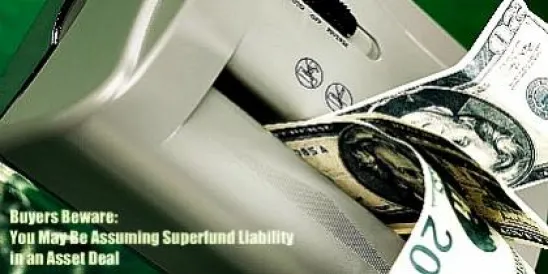On December 19, 2011, the United States District Court for the Eastern District of Wisconsin held that a company can assume Superfund liability through an asset purchase agreement (and have direct liability to the U.S. government) even if the seller continues to exist. At the urging of the government, the federal court in United States of America v. NCR Corp. and Appleton Papers Inc. reversed its earlier determination that there could be no successor liability in an asset deal where the originally liable seller continues to exist.
The Road to Successor Liability
The government had initially sought a preliminary injunction from the court finding that Appleton Papers Inc. (API) and NCR Corp. were liable for remedial costs under the Comprehensive Environmental Response, Compensation and Liability Act (CERCLA) at a PCB-contaminated Superfund site. The court granted the injunction regarding NCR, but denied it regarding API because the latter entity was unlikely to have successor liability resulting from its 1978 purchase of certain assets of NCR. Subsequently, when API filed a motion for summary judgment on the issue of successor liability, the court admitted that it had "already effectively ruled in favor of API" but denied the motion because of the government's persuasive arguments as to why API's asset purchase created liability.
In taking this surprising action, the court first discussed the four established ways in which a purchaser of assets can be deemed a successor: (1) where there is an express or implied agreement of assumption; (2) where the transaction amounts to a consolidation or merger of the purchaser or seller corporation; (3) where the purchaser is merely a continuation of the seller; or (4) where the transaction is for the fraudulent purpose of escaping liability for the seller's obligation. The API case involved only the first of these.
In the 1978 asset purchase agreement between the two entities, API agreed to assume NCR's liability with respect to certain scheduled matters and "with respect to compliance of the Property…with all applicable federal, state and local and other governmental environmental and pollution control laws." CERCLA, however, had not been enacted at the time of the agreement, and the PCB problem at issue in the case had not been scheduled.
The court acknowledged that its decision at the preliminary injunction stage was premised on two primary considerations. First, "the purpose of corporate successor liability is to prevent corporations from evading their liabilities through changes of ownership," and here, NCR remained a viable and liable entity for the remedial costs. There was no attempt to evade liability via the asset purchase agreement. Thus, on its face, the case "does not cry out for the application of the successorship doctrine." Second, the court noted that there was no real precedent for finding successor liability when the seller remained a viable entity.
Ultimately, the court reversed its decision after the U.S. government persuasively argued that, although parties may not transfer away or eliminate CERCLA liability via asset purchase agreements, they can create additional liability on the part of the buyer or anyone else. While the case law is clear that CERCLA precludes efforts to divest liability, that is not the same thing as prohibiting a party from becoming liable in addition to the liable seller. CERCLA, argued the U.S. government, only requires the directly liable party—here NCR—to remain liable. Therefore, the court was free to find that API joined in that liability via a broad reading of the 1978 agreement.
What would be the purpose of such a "transfer" of liability to an additional party, if the directly responsible party was still on the CERCLA hook? The court reasoned that "the seller has obtained something of value: an additional defendant to help share the burden of defense." In addition to being commercially reasonable and saving the seller the trouble of collecting on its indemnification agreements, transferring liability furthers the purpose of CERCLA by establishing additional parties to pay for cleanups.
The Upshot for Parties in an Asset Deal
This decision should give asset purchasers caution and sellers hope if the broad assumption of liabilities or indemnities is included in their asset purchase agreements. It also opens the door for the U.S. government to argue that both parties to an asset purchase agreement—under which liabilities are arguably assumed by the purchaser—may have direct liability to the government. However, it appears that the Wisconsin court is still recognizing the importance of CERCLA's bar against one party claiming, as a defense to a government cost-recovery suit, that it has transferred liability to another party that agreed to assume that liability by contract. It will be interesting to see if other courts expand this decision to private cost-recovery actions, or if they will view it as yet another Superfund imbalance in favor of the government.
Meanwhile, businesses should carefully consider whether the terms of their asset purchase agreements could create additional environmental liabilities that were not contemplated by the parties to the contract.




 />i
/>i

